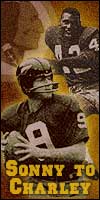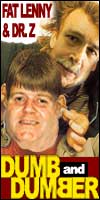More details. More than a rumor.
NHL deal reached
By ERIC DUHATSCHEK
Wednesday, July 13, 2005 Updated at 3:05 PM EDT
Globe and Mail Update
E-mail Eric Duhatschek Read Bio Latest Columns
Peace finally came to the National Hockey League Wednesday morning, but the price was steep. The 301-day lockout, a record for professional sport, crippled an already fragile industry, saw more than $2-billion in revenue go up in smoke and left the league looking at a bleak future going forward.
Even the official announcement of the new six-year collective bargaining agreement came in a short, muted three-paragraph statement, jointly issued by the league and the NHLPA, which said the two sides had "reached an agreement in principle" but added that, "details of the new agreement will not be made available publicly pending the formal ratification process."
The release went on to say: "It is anticipated the ratification process will be completed next week, at which time the parties will be prepared to discuss the details of the agreement and plans for next season. No further comment will be made until then."
To end the longest labour dispute in professional sports history, the players did something they said they never would in the early days of the lockout: accept a salary cap. In fact, the salary cap that they rejected in February — a $42.5-million offer that came from the league at the 11th hour — will come in about $3 million per team less than the deal they finally accepted.
Even in the absence of official details, NHL owners got pretty much what they wanted in a new collective bargaining agreement — a $39 million (U.S.) salary cap in the first year of the agreement, plus limits on entry-level salaries and team-friendly regulations on a number of key systemic issues, including salary arbitration.
Sources indicate that player contracts will be rolled back 24 per cent, as expected. The salary cap will fluctuate from year-to-year, based on audited league revenues. For next year, the players will receive 54 per cent of projected league revenues of $1.8 billion, with a $39 million spending ceiling and a $21.5 million spending floor.
No player can earn more than 20 per cent of the team cap, which puts the individual player maximum for next year at $7.8 million. All existing contracts will be grandfathered on a rolled-back basis.
Of the 288 NHL players under contract for 2005-06, only one — the New York Rangers' Jaromir Jagr — will exceed $7.8 million, after the rollback (Jagr is at $8.36 million). The next three highest-paid players (the St. Louis Blues' Keith Tkachuk, the New York Islanders' Alexei Yashin and the Detroit Red Wings' Nicklas Lidstrom), will all earn $7.6 million, after the rollback.
Players will be required to deposit a percentage of their salaries into an escrow account at the start of the season and it will stay there until revenues for that year are calculated. If league-wide salaries exceed 54 per cent of revenues, the players will be obliged to return a portion of their incomes from the escrow account. There is no fixed percentage as to how much will go into the escrow fund. Instead, it will be determined over the course of the year.
The new agreement also includes two-way salary arbitration for the first time, meaning a team can take an unsigned player to arbitration, something they previously did not have the right to do.
A weighted NHL draft lottery that will give every team a mathematical chance at landing Sidney Crosby will take place in conjunction with the NHL board of governors' ratification vote. The draft is tentatively set for Ottawa on July 30, largely because so many NHL scouts will be at work scouting international competitions in early August.
Every team will have at least one chance to land Crosby but no team will have more than three. Altogether, there will be 48 ping-pong balls in the drum, and four teams (Buffalo, New York Rangers, Pittsburgh and Columbus) will have the maximum number.
Of the six Canadian teams, Calgary and Edmonton will get two chances at Crosby. The remaining four will have just one shot each.
The six-year agreement also includes a reopener after four years, meaning the players can terminate the deal at that time if they are unsatisfied with how it has impacted them.
Buffalo Sabres' defenceman James Patrick, a veteran of the '94 lockout, said he expected that the players will ratify the agreement.
"I do know that some people are upset with the deal and that some agents may push their clients not to ratify," said Patrick, "but if the executive committee is recommending that we approve this, I expect it will be passed. We're in a different time now than we were two years ago. We have to move forward from here on in. You can't go back.
"I'm confident it'll be ratified. Based on conversations I've had with teammates, I don't think a lot of players are willing to extend this to 18 months or two years. Guys want to play next year."
Player agent Anton Thun, president of AKT Sports Management Consultants, Inc., also believes the players will vote in favor of ratification.
"For three reasons," said Thun, who represents Glen Murray, Mike Ricci and other prominent players. "One, there is the tendency of players just to go with the flow. Secondly, players will want to get back playing and they can't see a light at the end of the tunnel if they don't ratify. Three, the majority of players are going to understand that this is the best deal they're going to get currently and that if they don't take the deal that's on the table, the great unknown is out there.
"That great unknown probably leans towards worse, not better."
Sources indicated that the NHLPA will bring as many players as possible to Toronto for meetings Wednesday and Thurday to analyze the new deal.
"They'll break it into teams, have microphones connected to each room so questions can be raised and then they'll have a vote — in person, for the guys who are there and on line, for the guys who can't make it in."
The NHL board of governors is expected to rubberstamp the agreement in a unanimous vote, but the results of the two votes will be released simultaneously.
Once ratification occurs, the 30 teams can get down to the business of re-launching hockey, which will involve a mad frenzy of signing, trading and buying-out players that will serve as a far more valuable marketing tool than any campaign, designed to woo disenchanted fans back into the 30 NHL buildings.
Calgary Flames' captain Jarome Iginla, the team's player representative, is looking forward to seeing how that unfolds.
"It'll be exciting to see the free-agent frenzy," said Iginla, in an interview. "I'm sure that'll get some buzz and excitement going."
Iginla will be one of the most interesting test cases of the new system going forward. At 28, he is unsigned at the moment. With the age of unrestricted free agency dropping from 31 to 27 over the course of the deal, Iginla could walk away from the Flames by the summer of 2007, if they cannot get him locked up to a new, long-term contract.
Because of the uncertainty involves in the game's new economics, many observers believe the vast majority of players will opt to sign one-year contracts this summer, just to get back playing — and then defer the decision on longer-term deals until the two sides can better understand and appreciated the new economic system.
Some agents, anticipating a new deal, have already made preliminary contact with teams, setting up times to begin the long, complex job of getting contracts hammered out.
Iginla is currently skating with a handful of other NHL players in Kelowna, B.C. and suggested the pace of their workouts stepped up in the past little while, as it became more apparent that a negotiated deal was on the horizon.
"I'm really anticipating next year," he said. "It's been a tough negotiation, a tough time. I've never been through anything like this before. It's been a learning process. I didn't know what to expect.
"Now, I'm kind of in the mode of preparing for a regular season, so it doesn't feel as tough as it was during the season. Now that it's summer, I'm training as if there's a normal training camp coming."
One of the first orders of business for the league will be to get a schedule out. In addition, once ratification takes place, the NHL will announce the terms and location of the 2005 entry draft, in which every team will have a theoretical chance to land the most anticipated teenager of a generation, Sidney Crosby.
Iginla believes that players themselves will have no problem getting ready for an on-time start to training camps.
"I don't think it would be a problem as a player," he said. "I saw a lot of different guys at the rink that look in good shape and are training hard, so I imagine they have the same outlook as me — they're preparing for a middle of September camp.
"I think it's definitely possible for players to get ready. The other side — the management and marketing — that might take a little longer."
The beginning of a breakthrough in the negotiations came in early May, or when most of the hockey world was focused on the world championships in Austria.
Originally, both commissioner Gary Bettman and NHLPA executive director Bob Goodenow and their chief lieutenants were scheduled to make an appearance at the world championships, something that would have delayed talks again.
Instead, because the two sides were finally making progress, they decided to press on, working mostly in small groups as opposed to one large bargaining session. That dynamic, in turn, helped them overcome some of the animosity that had built up through years of rhetoric and ultimately led to today's resolution.
The season is scheduled to start on time and when it does, the league will have what it believes is a new, viewer-friendly look.
As part of its campaign ("A Whole New Game") to win back a disenchanted fan base, the league will look at half-a-dozen rule changes, including a shootout to decide games, smaller goaltending equipment, altered offside rules to open the game up and one more attempt at cracking down on the obstruction that has taken much of the speed and flow out of the game.
The goal is to enhance scoring, but also to increase scoring chances. In general, the vast majority of goals scored in the past decade came from the edge of the goal crease, not exactly the sort of thrill-a-minute style of play that had Sports Illustrated talking about hockey as a "hot" property in the early 1990s.
One of the first orders of business for all 30 general managers will be to learn the terms of the new CBA and how it may affect their hockey operations for the upcoming year.
The Boston Bruins, with only five players under contract, will be in a strong position to bid for the hundreds of free agents expected to be made available in the new agreement. Other teams, such as the Toronto Maple Leafs and the Detroit Red Wings, may need to avail themselves of the buyout provisions of the new deal in order to get under the salary cap in the first year.
A dozen of the league's most prominent players of the last two decades face uncertain futures, including Mark Messier and Ron Francis, the No. 2 and No. 4 all-time scorers in league history. Messier turned 44 last January and has played more NHL games (1,756) than anyone except Gordie Howe. Messier was vague about his intentions during the lockout, but he may not have a choice in the matter anyway if the New York Rangers, his previous employers, decide to stick with their plans for a youth movement.
Similarly, Francis, 42, ended up in a Toronto Maple Leafs' uniform at the end of the 2004 season, but he lives in Raleigh, N.C. and presumably would retire if the Carolina Hurricanes aren't interested in brining him back. Brett Hull, No. 6 on the all-time scoring list, signed a two-year contract with the Phoenix Coyotes last summer. Assuming the Coyotes don't buy him out, Hull will likely return this season, but the lockout year probably cost him any chance of catching for second spot on the all-time goal-scoring list (he is currently 61 goals behind).
Other players facing the possibility of a forced retirement include James Patrick (Buffalo), Chris Chelios, Steve Yzerman and Steve Thomas (Detroit), Dave Andreychuk (Tampa), Scott Stevens (New Jersey) and Luc Robitaille (Los Angeles).
Defenceman Al MacInnis, who turns 42 on July 11, played only three games in the 2003-04 season because of the recurrence of an eye injury and he will likely retire as a result.
Even though the age for unrestricted free agency stay at 31 for this year (it will drop to 27 over the course of the agreement), a number of the NHL's top stars will be eligible to shop their services to the highest bidder.
They include Scott Niedermayer, Mike Modano, Glen Murray, Teemu Selanne and others.
Once teams get around to offering waivers or buyouts on players currently under contract, the number of potential unrestricted free agents will increase.






